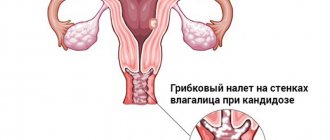A woman at any age can face the problem of candidiasis - known to most people as thrush. The disease provokes a several-fold increase in Candida fungi, which are normally found in the vaginal microflora of every woman. Neither social status nor anything else can insure against this unpleasant disease. Because various factors can provoke an increase in fungi: stress, changes in diet, taking medications, and other concomitant diseases.
Thrush can affect women of any age
This disease poses the greatest danger to pregnant women. Because during this period the body is weakened and any disease is much more difficult to treat. But there is also a risk of fetal infection.
Bacteriological examination for thrush
Bacterial culture to detect thrush
When you have thrush, the doctor almost always prescribes a bacteriological examination of a vaginal smear. A bacteriological smear is a fairly simple analysis with which you can determine which microbes (flora) and in what quantity (which is very important) are in the vagina, uterus, cervical canal and urethra.
Content:
A smear for flora differs from a smear for cytology (diagnosing cervical cancer conditions). Against the background of all kinds of gynecological diseases, and also those that are sexually transmitted, the composition of the microflora changes. By the nature of changes in microflora, the cause of the disease can be determined. The composition of the vaginal microflora determines the microflora of the organs that are nearby: the urethra and the cervix.
Complications of thrush
If the infection is not treated promptly, yeast-like candida fungi grow deep into the body, affect blood vessels, and enter the blood. After this, pathogenic microorganisms spread throughout the body. In this case it is observed:
- the emergence of new foci of the disease;
- development of bleeding;
- sexual dysfunction;
- spread of infection to neighboring organs.
Fungal overgrowth if left untreated causes:
- abortion;
- infection of the fetus during childbirth;
- damage to the digestive organs;
- the occurrence of allergic reactions;
- kidney dysfunction;
- cystitis;
- infertility;
- the appearance of adhesions in the vagina;
- damage to the cervix that causes cancer;
- development of purulent infections;
- death.
Thrush is like a boomerang - it can come back again and again. Candidiasis can affect the cervix, bladder and urethra. Cystitis, cervicitis, urethritis are all complications of this disease.
If thrush is accompanied by sexually transmitted infections, there is a risk of inflammatory processes that can lead to infertility. There is no need to be scared, because we are talking about cases when a woman for some reason does not go to the doctor, or independently uses medications that are not suitable for her.
There are many medicines for various gynecological diseases, including vaginal suppositories, which we have already written about earlier. But not every drug is suitable. Gynecologists, if therapy occurs without visible progress, can replace one drug used with another.
You may be interested in: How to treat thrush.
Severe recurrent thrush may indicate problems with immunity, then it is important to find out the reason for its decrease. There are cases (albeit infrequent) when acute thrush signaled diabetes mellitus and even HIV.
Particular attention should be paid to the treatment of thrush in women expecting a child. Firstly, their immunity is weakened and their hormonal levels change, and these are favorable conditions for the development of bacteria in the vagina.
Secondly, pregnant women need to worry not only about themselves: thrush can also threaten the unborn child. While the baby is inside, candida and other fungi cannot get close to him, but during childbirth they can get into the baby’s eyes, mouth and nose.
If at the time of pregnancy a woman already has an advanced stage of thrush, which has spread to internal organs, candidiasis may occur in an unborn child. Cases are very rare, but often result in premature termination of pregnancy.
As for the expectant mother, she may also have a difficult time during childbirth. After all, the fungus leads to a loss of elasticity of the vaginal tissues and increases the number of ruptures. The matter, you understand, is unpleasant.
But with the right approach to treatment, complications of thrush can be avoided, and this largely depends on the woman herself.
You may be interested in: Vaginal discharge: what does the color mean?
How to prepare for taking a vaginal smear?
To do this you need:
- One or two days before the examination, you must abstain from sexual intercourse.
- 2-3 days before the examination, stop using intimate hygiene products and douching.
- A week before the examination, you should not take medications in the form of vaginal tablets, suppositories and sprays.
- Before the examination, perform hygiene only with water, without detergents. In the morning, do not wash your face at all.
- It is advisable not to urinate two to three hours before the examination.
On what days of the menstrual cycle should a smear test be taken?
A bacteriological smear from the vagina is taken in the first days after the end of menstruation or before the start. If you start your period on the scheduled date, contact your doctor and reschedule your appointment.
How is a vaginal smear taken?
Bacteriological smear from the vagina
To carry out a bacteriological analysis, a small amount of mucus and discharge is taken from the vaginal area, urethra and cervix. This test is usually taken at every visit to the gynecologist.
The first stage is a gynecological examination, during which the gynecologist inserts a metal or plastic dilator into the vagina, selected according to the size of the patient in each individual case. During the procedure, you need to relax, breathe evenly and deeply - this will relieve discomfort.
The second stage - after examining the walls of the vagina and cervix, the doctor, using sterile swabs, collects a small amount of discharge from the vagina, uterus, cervical canal and urethra. This procedure is practically painless.
The third stage - the secretions collected using a swab are applied by a doctor to special glasses, which are sent to the laboratory, where they are stained and studied under a microscope. Results can be ready in a few hours.
How you feel after taking a vaginal smear
Taking a vaginal smear is well tolerated without complications. Only sometimes, after examination and taking a smear, minor pain in the lower abdomen or scanty discharge may occur, which disappear a few hours after taking. After such an examination, you do not need to follow any regime and refuse sexual intercourse. If blood discharge appears within a few days after taking a smear, you should consult a doctor.
How is a vaginal smear taken during pregnancy?
During pregnancy, it is recommended to undergo bacteriological analysis at least three times for preventive purposes. The second and third smears are taken in the middle and at the end of pregnancy. A gynecological examination is completely harmless to the fetus and the pregnant woman.
What diseases are detected using a vaginal smear?
Detection of diseases using a smear and examination
A vaginal smear to determine microflora diagnoses diseases such as cervicitis, vaginitis, thrush (candidiasis), bacterial vaginosis, as well as STDs (sexually transmitted diseases) - gonorrhea, chlamydia, ureaplasmosis and trichomoniasis. At the discretion of the doctor, this study is supplemented by a cultural study - this is a quantitative determination of the content of microbes in the genital tract and the PCR diagnostic method, which almost accurately determines multiple infections that are sexually transmitted.
What is candida fungus
Related articlesCream for fungus on the skinFungus on the bodyFungus on the body
- round shape;
- about 10 microns in size;
- live at temperatures up to 37 degrees;
- are resistant to adverse conditions.
When, for some reason, a decrease in immunity occurs in the body, rapid growth of yeast fungi begins. The normal microflora is disrupted. This situation causes:
- development of candidiasis - thrush;
- nail damage;
- spread of infection in the oral cavity;
- inflammation of the intestinal mucous membranes;
- disease of the respiratory system and nervous system.
How is it transmitted?
The main danger of candidiasis is that the infection spreads at high speed. Candida quickly affects the mucous membranes of the entire body. The fungal disease is sexually transmitted through unprotected sex. Possible infection through:
- Food;
- bed sheets;
- Houseware;
- poorly washed fruits and vegetables;
- kisses;
- toys;
- gaskets;
- personal hygiene items.
A yeast-like fungus can enter the body during medical intervention during a gynecological or dental examination with a poorly processed instrument. Candida albicans is transmitted by:
- from a woman to a child during childbirth;
- by airborne droplets;
- newborns through poorly washed diapers;
- when using other people's objects, clothes.
Fungus on hands
Douching for thrush
Fungus on the skin
For the complex treatment of fungal infections, folk recipes are used. It is important that the use is agreed with the doctor and takes place after diagnosis. It is recommended to drink a spoonful of wormwood root decoction a day - 20 g of leaves per glass of boiling water.
- in the form of baths daily for candidiasis on the penis;
- as a lotion several times a day - for fungus in the mouth;
- for thrush in women - for douching every other day.
What tests should be taken for thrush?
A woman at any age can face the problem of candidiasis - known to most people as thrush. The disease provokes a several-fold increase in Candida fungi, which are normally found in the vaginal microflora of every woman. Neither social status nor anything else can insure against this unpleasant disease. Because various factors can provoke an increase in fungi: stress, changes in diet, taking medications, and other concomitant diseases.
Thrush can affect women of any age
This disease poses the greatest danger to pregnant women. Because during this period the body is weakened and any disease is much more difficult to treat. But there is also a risk of fetal infection.
Classification
When pseudomycelia are detected in tests, depending on the rate of fungal reproduction and the severity of the disease, the types of candidiasis are distinguished:
- superficial – initial stage – treatable, pathogenic bacteria act on skin tissue, nails, mucous membranes;
- systemic type - penetrates the epithelium, can affect the respiratory system, digestive organs;
- sepsis is a condition in which candida is detected in the blood, poisons the entire body, and death is possible.
There is a classification of candidiasis according to the form of the fungal disease:
- Acute - has pronounced symptoms, with timely diagnosis it is quickly cured. When neglected, it is called terry and infects epithelial tissues.
- Chronic – appears due to improper treatment, lack of sensitivity to drugs.
- Candida-bearing - tests show the presence of a huge amount of candida without external manifestations of the disease. A person is a carrier of the fungus and can infect others.
Skin fungus on the legs - how to treat it
Antifungal ointments
Clotrimazole cream
When to get tested for candidiasis
Every woman is at risk of encountering the problem of thrush. But you should only visit a doctor to diagnose thrush if you have the following symptoms:
- itching;
- curdled discharge;
- pain when urinating;
- sour milk smell of discharge.
It is necessary to undergo examination for the presence of Candida fungi in the presence of the following diseases: vaginitis, urethritis, vulvitis, cystitis. Modern diagnostic techniques make it possible to determine which fungus provoked the development of thrush. This helps to determine which medications the fungus is most sensitive to and select the correct treatment method.
When and from whom is blood taken for candidiasis?
The development of thrush is usually indicated by characteristic symptoms, but in some cases they appear only in one of their sexual partners. In this case, it is necessary to conduct a comprehensive examination to identify candidiasis.
In addition, a blood test is performed if it is difficult to determine the cause of the activation of pathogenic microorganisms. In this way, it is possible to identify the development of an infectious disease, diabetes mellitus and a number of other problems.
To make a diagnosis of thrush and select a therapeutic course, a visual examination is not enough for a specialist. Laboratory tests must be carried out, thanks to which it is possible not only to identify candida fungi in the body, but also to determine their susceptibility to certain medications.
Tags: analysis, what, thrush, prescribe
About the author: Admin4ik
« Previous entry
Diagnosis of candidiasis
Many women put off visiting a gynecologist out of fear that diagnosing thrush is a difficult and painful process. And all because they don’t know how to identify thrush. All their fears are unfounded, because in most cases a simple smear is enough to detect candidiasis. This procedure allows you to determine the presence of fungi in the vaginal microflora.
The doctor takes a scraping (smear) in the place where the fungus is concentrated, and in the laboratory specialists carefully study the resulting material under a microscope.
Candida fungi detected during a smear confirm the presence of thrush in a woman. Testing for thrush gives the doctor complete information about the disease. Therefore, if symptoms of the disease appear, you should not self-medicate, but rather visit a gynecologist and undergo the necessary tests. An accurate diagnosis will allow you to get rid of candidiasis as quickly and painlessly as possible.
A gynecological scraping is checked for the presence of fungus using a microscope
What can smears tell?
Yeast fungi of the genus Candida live on the vaginal mucosa of any woman. This subspecies of opportunistic microorganisms, in normal quantities, does not cause negative reactions and does not provoke the disease thrush. The norm for the content of candida albicans is up to 10 to 4 degrees CFU/ml. Any excess amount of fungi is considered dangerous and can cause thrush at any time.
When conducting tests, pseudomycelium of yeast fungal spores is sometimes found, in this case the morphology confirms the development of pathology. Abnormal reproduction has the following causes:
- puberty;
- pregnancy;
- menopause;
- treatment with certain medications: antibiotics, corticosteroids, hormonal contraceptives.
In addition, the development of fungal microorganisms can be triggered by a deficiency or excess of estrogen. Multiple pathogens affect patients with:
- diabetes;
- tuberculosis;
- STD;
- chlamydia;
- trichomoniasis;
- gonorrhea;
- genital herpes.
If candida is found in a smear, only a specialist can figure out what it is. Spores may appear due to external provoking factors: heat, dark synthetic underwear, frequent douching, infection through sexual contact, stress, decreased immunity.
Important! Pregnancy is a common cause of the appearance of candida on the mucous membranes. During the process of bearing a child, hormonal levels undergo changes that affect the vaginal environment. Increased sugar levels observed during pregnancy also provoke the appearance of candidiasis in women. It is necessary not only to identify the disease in the early stages, but also to completely cure candidiasis.
A Candida smear will tell you how dangerously high the number of fungal spores is. When bacteriological analysis is carried out and an excess of the norm is detected, the risk of dangerous consequences increases significantly. Yeast in a smear is the main sign of thrush, which if left untreated can lead to infertility.
Reasons for the appearance of cocobacillus in a smear in women
Types of analyzes
In addition to the simplest way to diagnose candidiasis using a vaginal smear, there are other methods for determining thrush. PCR, enzyme immunoassay, and culture for Candida albicans are used. Because these two methods allow you to most accurately identify the type of fungus. Each of these types of research has its pros and cons. What they all have in common is that they are painless. Only a doctor can decide which thrush test a patient should undergo. Most often, several types of tests are prescribed simultaneously; this is necessary to increase the accuracy of the diagnosis.
How to treat candidiasis at home
Treatment of candidiasis must be carried out in several stages. First, it is necessary to stop the proliferation of candida fungi, and then restore normal intestinal microflora.
There are many ways to stop candida overgrowth, including dietary changes, antifungal medications, and natural antimicrobials. A combination of all these methods works most effectively.
Here are some useful tips:
Reduce your intake of sweets and other carbohydrates
This includes products such as:
The fungus loves sugar. Try to minimize your consumption of candy, sweets, alcohol, refined flour products, sugary carbonated drinks, sweet coffee drinks, and also give up fruits, honey and other natural sugars for a while.
Complex carbohydrates such as whole grains, beans, lentils and potatoes are healthy, but they also contribute to the development of candida and should be limited during treatment.
These foods can aggravate the growth of candida and help it spread. Reduce your intake of these foods to a minimum until symptoms subside.
Read the ingredients of products carefully, as many of them contain sweeteners and a lot of sugar.
If you have strong cravings for sweets, try to choose fruits with a low glycemic index, such as: cherries, apricots, plums, grapefruits, peaches, apples, pears, strawberries, oranges.
Eat more antifungal foods
There are several products that have the properties of natural antibiotics, but at the same time do not have the side effects of drugs.
- Raw garlic contains sulfur compounds and has antifungal properties.
- Apple cider vinegar will also help you fight candida. To do this, dissolve 1 tablespoon of apple cider vinegar in a glass of water at room temperature. Drink the drink 30-60 minutes before meals.
Antifungal products also include: onion, coconut oil, chamomile, lavender, ginger, lemon, hot pepper.
Take probiotics and prebiotics
Probiotics contain beneficial bacteria that help reduce the negative effects of an imbalance of this fungus. This can be kefir, natural yogurt, as well as probiotic supplements.
Fermented vegetables and fermented milk products contain beneficial cultures that help get rid of candida overgrowth, such as L. acidophilus, L. rhamnosus, L. casei, and S. Boulardii.
It's also important to remember about prebiotics , a certain type of indigestible fiber in fruits, vegetables and other plant foods that feed the beneficial bacteria in your gut. These include garlic, onions, bananas, barley, oats, apples, cocoa, flaxseed and others.
Strengthen your immune system
To do this, it is important to adhere to the principles of a healthy diet, rich in lean proteins, healthy fats and low in carbohydrates. All foods you eat should be fresh and as natural as possible. This means you need to limit your consumption of processed foods, which are full of additives, heavy metals, pesticides and other harmful substances.
The next step is to support the immune system with vitamins and minerals such as:
- Chlorella is an algae that contains many vitamins and minerals that help the body get rid of heavy metals and pesticides.
- Vitamin C – Since we get most of our vitamin C from fruits, you may become deficient if you limit your fruit intake. Spinach and broccoli also contain high amounts of vitamin C.
- Vitamin E is a powerful antioxidant that helps our body fight infections. Foods rich in vitamin E include nuts, seeds and spinach.
Do not take antibiotics without a doctor's prescription
Antibiotics only treat bacterial infections. At the same time, many people take them to treat colds and flu, which worsens the candida problem. After all, antibiotics destroy not only harmful bacteria, but also beneficial lactobacilli, which creates an ideal environment for the proliferation of fungi.
Polymerase chain reaction
One of the effective laboratory tests is PCR. This type of analysis allows you to detect DNA or RNA of yeast fungi in the patient’s biomaterial. The material for the study is venous blood.
This type of study is carried out to determine the number of albicans fungi. It is worth noting that this fungus is most often the causative agent of candidiasis. With this analysis, material taken from a woman is compared with the genes of the fungus and the most accurate number of fungi in the microflora is obtained. It is rightly considered an informative and accurate analysis. It is almost impossible not to detect candidiasis using this method, because not a single fungal cell will go unnoticed.
It is important to carry out PCR for chronic thrush, when symptoms worsen at certain intervals. Accurate determination of the type of fungus that caused candidiasis guarantees the choice of the correct treatment and a speedy recovery.
Polymerase chain reaction is the most accurate method for detecting thrush
Why are there no IgG antibodies to Candida in the blood during examination?
Immunoglobulins to candida of three types can be detected in the blood. These include IgG, IgA and IgM.
In practice, IgG is most often determined. Assessing the concentration of the analysis over time allows the doctor to obtain all the necessary information about the severity of candidiasis, the success of treatment, etc.
IgA are immunoglobulins that protect human mucous membranes from infectious agents. With candidiasis, their level does not increase in all patients. This depends on the severity of the pathology, timing of infection and localization of the fungal infection.
IgM can be detected during primary infection with candida, during acute infection. But immunoglobulin M disappears quite quickly. In the future, it may be detected during exacerbations, but its level is less than during primary infection.
In addition, IgM may not increase at all. Considering that candidiasis is often chronic, the diagnostic value of immunoglobulin M determination is limited. The most informative is the assessment of the IgG level. Therefore, we will talk about this class of immunoglobulins in more detail.
Determination of IgG immunoglobulin in the blood is not a reason for prescribing treatment. Because it can be detected in healthy individuals, as well as in asymptomatic carriers or in cases of candidiasis in the past.
Candida is present in the body of any person. But in most cases they do not cause an inflammatory response. Therefore, the indication for therapy is the presence of symptoms of candidiasis of the skin, mucous membranes or internal organs.
Determining the level of IgG in the blood is not an accurate test. It is indicative rather than confirmatory.
Therefore, a positive diagnostic result requires additional studies to confirm the diagnosis. After this, therapy may be prescribed.
IgG antibodies may not be detected during examination in the following cases:
- the person does not have invasive (deep) candidiasis;
- false negative result.
Superficial candidiasis does not always lead to an increase in IgG levels. Accordingly, with candidal urethritis, vaginitis or balanoposthitis, antibodies in the blood may not be detected. But sometimes with deep candidiasis, false negative results occur.
That is, a person is sick, but blood antibodies are not detected. This most often occurs in one of two cases:
- Too little time has passed since the infection worsened (less than 2 weeks), and antibodies have not yet had time to develop;
- due to severe immunosuppression (for example, in AIDS), the production of antibodies is impaired (the immune system is weakened and cannot produce them in sufficient quantities).
Sowing for Candida albicans
To conduct this type of research, material is taken from a place where fungi accumulate and placed in a nutrient medium. If the material taken contains Candida fungi, then once in an environment favorable for them, they will begin to multiply. Soon they will be visible even without special devices. To select treatment, several drugs are applied to fungal colonies and it is observed which of them will kill the fungi. Based on the data obtained, doctors can make a conclusion to which drugs the fungi are most sensitive to.
The fungus Candida albicans can be easily identified using bacterial culture
Flora smear
One of the least complex, but at the same time effective methods for diagnosing “female” diseases is taking a smear on the flora . Specialists take material for analysis from the urethra, from the vaginal mucosa or cervix.
When deciphering the results, not only the presence of pathogenic microorganisms can be revealed, but also deviations at the hormonal level and the presence of cell pathology in relation to cells are revealed. Many diseases are diagnosed in this way - from the banal “thrush” to dangerous infections.
It is difficult to overestimate the importance of this simple research, so it should not be neglected.
A smear test is recommended once every three months for the purpose of prevention (with the same frequency, women usually undergo examination by a gynecologist for similar purposes).
But there are situations when it is urgent to take a smear for flora. First of all, it makes sense to see a specialist if the following symptoms are observed:
Planning a pregnancy also requires a mandatory smear test for flora.
After a course of treatment for gynecological diseases, the doctor will prescribe a control smear test to ensure the effectiveness of the measures taken.
A study for the purpose of prevention is recommended for women who have undergone antibiotic therapy, since these substances tend to affect healthy flora, and for those who have recently changed sexual partners.
Additional Information
Source: https://molochnica-help.ru/diagnostika-molochnicy/mazok-na-floru/
Preparing for tests
The accuracy of the analysis depends not only on the type of study, but also on how prepared the patient was for it. To get an accurate result, a woman will need to prepare in advance. The preparation process directly depends on the research method. Patients undergo several tests to accurately diagnose the disease. The material for the study can be: biomaterial (smears) from the vagina, venous blood, urine and feces. Most often, patients are prescribed a smear, urine and stool test. In this case, a week before the date of the study, the patient must stop taking any medications.
The day before the tests, avoid intimacy and alcoholic beverages. In addition, a woman must consult a gynecologist on which day of the menstrual cycle to take a smear test.
An accurate diagnosis cannot guarantee effective treatment and quick recovery if the patient does not adhere to the doctor's recommendations. Therefore, her recovery depends only on the patient herself. A woman must undergo tests in a timely manner and follow the doctor’s recommendations as accurately as possible.
Treatment
How is it transmitted?
Fungus on hands
Fungus on the skin
To remove the fungus, it is necessary to boost immunity and cure chronic diseases that weaken the defenses. An important role is played by the restoration of the normal microflora of the body. How to treat candidiasis?
- immunomodulators;
- vitamins C, group B;
- for local use - antimycotic vaginal suppositories, ointments;
- inside – antifungal capsules, tablets;
- proper nutrition;
- restriction of sexual contacts;
- disinfection of linen;
- performing hygiene procedures;
- treatment of the sexual partner.
In order for the body to get rid of the infection, it is necessary to act on the fungus. Medicines with a fungicidal effect, which damage bacteria and spores of microorganisms, help to cope with pathology. Dermatologists prescribe:
- inside the vagina - suppositories Livarol, Lomexin;
- for external treatment – Clotrimazole ointment, Triderm cream;
- if nail fungus is detected - Fungoterbin, Diflucan;
- if the intestinal walls or respiratory organs are damaged, take Fluconazole or Nystatin tablets orally.
Medicines
In the presence of a disease, when the cause of infection is a fungus, therapy involves the use of medications. Their action solves various problems. Doctors prescribe:
- Candide - the active ingredient clotrimazole, available in the form of cream, powder, solution, treats fungus on the skin, genitals, and mouth;
- Pimafucin – has antifungal and antiviral effects, effective against thrush;
- Linex is a probiotic, restores microflora and bacterial balance;
- Viferon - activates the immune system, prevents cell division.
Food
To destroy the fungus in the body, you need to eat right. You should eat more leafy greens, lentils, and beans. There is cabbage, zucchini, bell peppers, and fresh fruit. It is necessary to exclude products that cause fermentation, contain yeast and substances that provoke fungus:
- refined sugar;
- baking from yeast dough;
- pickled preparations;
- wine;
- beer;
- vinegar;
- sauces;
- mushrooms;
- smoked fish;
- fruit juices;
- grape.
Antibodies of class M are formed the fastest. They are detected in the blood within a week after the onset of the inflammatory process. And after another 3-4 weeks they disappear, and may never appear again, even with subsequent relapses of candidiasis.
IgG appears after 2-3 weeks. Their titer changes over time. With each exacerbation of infection, it increases.
This occurs approximately 2 weeks after the next relapse.
Then, after completing a course of therapy, the level of IgG antibodies decreases to normal values. This happens within 2-4 weeks. Sometimes IgG levels remain elevated for longer – up to several months. Immunoglobulin G can be detected in the blood for several years after the infection.
What is most important is not so much the fact of the presence of antibodies, but rather their change in dynamics. If a person takes a control blood test for antibodies after treatment for thrush, and the results show that their level has decreased by 4 times or more, such a patient is considered cured. Moreover, even if the level of antibodies still exceeds the norm.
What tests should I take for thrush?
If Candida is suspected, it is recommended to conduct studies confirming the presence of the fungus in the body. In most cases (about 80%), doctors detect a type of fungus called candida albicans, one of the 150 fungi that infects our body.
In modern times, the following are often used for this:
- examining a smear under a microscope;
- bacteriological culture;
- linked immunosorbent assay;
- polymerase chain reaction.
All diagnostic methods have positive and negative sides, which is why doctors take into account tests for thrush in combination to avoid diagnostic errors.
Microscopic examination of a smear - examining a scraping from the site of infection under a microscope. If the preliminary diagnosis is “thrush”, a smear analysis is taken from the genital organs and the anatomical material is placed on a glass slide. If the result is positive, Candida albicans cells are found in the patient’s scraping and in this case there are no errors.
Bacterial seeding is the isolation of the biological material under study and its placement on a nutrient medium in which the suspected pathogens will grow. The fungus candida albicans is active in a nutrient medium - it actively reproduces and builds its colonies, which after a while can be seen even without a microscope. Growing fungi on a nutrient medium is quite popular, since in this study the doctor determines the sensitivity of fungi to drugs.
The most accurate analysis is called polymerase chain reaction - it allows you to isolate DNA or RNA fragments of the fungus with 98% accuracy. This is the most “sensitive” test for candidiasis. Completed within three days. Material: for women - scraping of the epithelium from the urogenital area, for men - ejaculate (but venous blood can also be examined).
How to identify thrush in men
Diagnosis of diseases in representatives of the stronger sex includes a visual examination and taking smears for laboratory testing.
| Study title | Interpretation |
| Smear from the head of the penis | Detection of a fungal infection indicates the presence of a disease, even if the process is asymptomatic. |
| Microscopic smear analysis | If fungi are detected on a glass slide under a microscope, the reaction is considered positive. |
| Bacteriological culture | If the disease is present, colonies of infection will grow after some time. |
As a rule, “male” candidiasis affects the genitals. In some cases, the disease can spread to the skin and mouth. The cause of this disease is the fungal flora of the genus Candida. Thrush in men can exist separately, or be a consequence of sexually transmitted infectious diseases.
The most dangerous is thrush that progresses at the last stage. The disease manifests itself in the form of pain and various types of discharge. Thrush also reminds you of its existence when you urinate, as well as when having sex.
Often, a man develops smegma, reminiscent of homemade cheese. The discharge has an unpleasant aroma.
Where should I contact?
Thrush is the most common genital infection. Therefore, tests to determine the disease have been carried out for a long time, and determining candidiasis is not difficult. If thrush is suspected, most patients go to a regular hospital. By the way, you can do the research in a private clinic.
According to the observations of patients, it is best to donate biomaterial where the attending physician works - communication with the laboratory is fast, there is no need to travel to different places for the results, and in private clinics the result will be in the doctor’s office upon a second visit.
Diagnosis of thrush in children
To make an accurate diagnosis, it is necessary to take a smear from the affected area, either the oral cavity or the external genitalia.
The doctor applies biological material to glass, dries it, stains it, and looks under a microscope. If colonies of a fungal infection are found in the field of view, then we can talk about thrush.
Diagnosis of oral candidiasis includes four components:
- patient complaints;
- microscopic examination of scrapings taken from the oral mucosa;
- clinical blood test results;
- study of glucose levels in blood serum.
The material is collected on an empty stomach before brushing your teeth or four hours after eating. After completing the course of treatment and disappearance of clinical symptoms, the study must be repeated.
What is the price?
Testing for candidiasis is generally inexpensive (cheaper in public hospitals, more expensive in private clinics). You can get tested for thrush not only at a medical institution - quite recently, quite a few private laboratories have appeared that accept a comprehensive range of tests, but do not provide services for the treatment of diseases. Typically, such “offices” are equipped with good diagnostic equipment, so there is no doubt about the reliability of the result.
When choosing a laboratory, you can take advantage of promotional offers. Many laboratories offer discounts on certain types of tests; the cost will be significantly lower, but the result will not change. The only inconvenience in the work of such laboratories is that the result must be collected and taken to the doctor yourself. Some diagnostic centers send results by email (the service is included in the price).
When choosing a laboratory, it is worth considering that in the metropolitan cities of Russia the price of the test will differ by a couple of hundred rubles from the price in another, smaller city. An enzyme immunoassay for candida in Moscow costs approximately 700-800 rubles, but a smear is half the price - 350-400 rubles.
Deviations from the norm
In a smear of a healthy woman, rod flora and leukocytes (small in quantity) are usually detected.
A large number of leukocytes, cocci, and the presence of red blood cells in the smear are evidence of an inflammatory process. Trichomonas are found in trichomoniasis, gonococci, respectively, in gonorrhea. The mucus often contains fungal mycelium, which is a sign of candidiasis.
Sources:
https://kandidoz.org/bakteriologicheskoe-issledovanie-pri-molochnitse/ https://econet.ru/articles/kandidoz-prostoy-sposob-proverit-nalichie-gribka-v-organizme https://molochnica-help.ru /diagnostika-molochnicy/mazok-na-floru/











